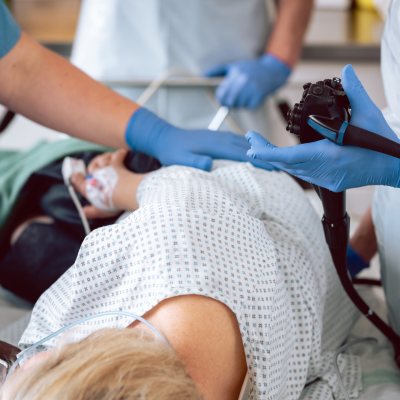GASTROENTEROLOGY

Endoscopy
Endoscopy is a minimally invasive procedure that allows healthcare providers to examine the interior of various organs and systems within the body using an endoscope, a flexible tube equipped with a camera and light. This technique is commonly used for diagnostic purposes, enabling the visualization of the gastrointestinal tract, respiratory system, urinary tract, and more.
Endoscopy can help diagnose conditions such as ulcers, tumors, and inflammation, and it may also be used for therapeutic purposes, such as removing polyps or taking biopsies. The procedure typically requires sedation, and patients can often return to normal activities shortly after. Our experienced team is dedicated to providing safe, effective endoscopic care tailored to each patient’s needs.

Colonoscopy
A colonoscopy is a minimally invasive procedure used to examine the inner lining of the colon and rectum using a flexible tube called a colonoscope. This procedure is essential for diagnosing conditions such as colorectal cancer, polyps, inflammatory bowel disease, and gastrointestinal bleeding.
During a colonoscopy, patients are typically sedated for comfort. The colonoscope is inserted through the rectum, allowing the physician to visualize the colon’s interior. If necessary, tissue samples can be taken for biopsy, and polyps can be removed during the procedure.
Preparation involves dietary restrictions and bowel cleansing to ensure clear visibility. Regular screenings are recommended, especially for individuals over 45 or those with a family history of colorectal issues. Our dedicated team prioritizes patient comfort and safety, providing comprehensive care throughout the process.

Sigmoidoscopy
A sigmoidoscopy is a diagnostic procedure used to examine the lower part of the colon (sigmoid colon and rectum) using a flexible tube called a sigmoidoscope. This procedure helps identify issues such as polyps, inflammation, bleeding, and signs of colorectal cancer.
During a sigmoidoscopy, patients are typically given a mild sedative for comfort. The sigmoidoscope is inserted through the rectum, allowing the physician to visualize the inner lining of the sigmoid colon. Biopsies can also be taken if abnormalities are found.
Preparation involves dietary restrictions and bowel cleansing to ensure clear visibility. Sigmoidoscopy is often used as a screening tool for colorectal cancer, particularly in individuals over 50 or those with a family history of colorectal conditions. Our dedicated team ensures a comfortable experience and provides thorough care and support throughout the procedure.

EST : Electrophysiological studies
Electrophysiological studies (EST) are diagnostic procedures used to evaluate the electrical activity of the heart. This testing helps identify arrhythmias, conduction issues, and other cardiac abnormalities. During EST, catheters are inserted into the heart through blood vessels, allowing doctors to map the electrical signals and pinpoint areas causing irregular heartbeats.
The procedure can also be therapeutic, as it may guide interventions like catheter ablation, where specific areas of heart tissue are destroyed to restore normal rhythm. EST is typically performed in a specialized setting, and patients are monitored closely throughout the process. Our experienced cardiology team is dedicated to providing comprehensive care and support for patients undergoing electrophysiological studies.
EVL : Endoscopic Variceal Ligation
Endoscopic Variceal Ligation (EVL) is a gastroenterological procedure used to treat esophageal varices, which are enlarged veins in the esophagus that can bleed due to liver cirrhosis or portal hypertension. During EVL, a flexible endoscope is inserted through the mouth into the esophagus, allowing the physician to visualize the varices.
Rubber bands are then placed around the varices to constrict and cut off their blood supply, reducing the risk of bleeding. This minimally invasive procedure is typically performed in a hospital setting and may be done on an outpatient basis.
EVL is effective in preventing variceal hemorrhage and is often used in conjunction with other treatments for liver disease. Our experienced gastroenterology team is dedicated to providing comprehensive care and support for patients undergoing this procedure.

Metallic Stent Insertion
Metallic stent insertion in gastroenterology is a minimally invasive procedure used to relieve obstructions in the gastrointestinal tract, often caused by tumors, strictures, or other conditions. The stent, typically made of metal mesh, is placed within the affected area to keep it open and facilitate the passage of food, fluids, or bile.
The procedure is usually performed using endoscopic techniques, where an endoscope is inserted through the mouth or anus, depending on the location of the obstruction. Imaging guidance, such as fluoroscopy, may also be utilized to ensure accurate placement.
Metallic stents are effective for managing conditions like esophageal cancer, biliary obstruction, and colorectal strictures. They can improve quality of life by alleviating symptoms such as pain, difficulty swallowing, and jaundice. Our dedicated gastroenterology team provides comprehensive care and support throughout the stent insertion process, ensuring optimal patient outcomes.

ERCP : Endoscopic Retrograde Cholangiopancreatography
Endoscopic Retrograde Cholangiopancreatography (ERCP) is a specialized procedure used to diagnose and treat conditions affecting the bile ducts, gallbladder, and pancreas. During ERCP, a flexible endoscope is inserted through the mouth, esophagus, and stomach into the duodenum. A contrast dye is then injected into the bile and pancreatic ducts, allowing for detailed imaging via X-ray.
ERCP is often used to identify issues such as bile duct obstructions, gallstones, pancreatitis, and tumors. In addition to diagnosis, therapeutic interventions can be performed during the procedure, such as stone removal, stent placement, or balloon dilation.
Patients typically receive sedation for comfort, and the procedure usually takes about 30 to 90 minutes. Our experienced gastroenterology team is dedicated to providing comprehensive care and ensuring optimal outcomes for patients undergoing ERCP.

Laser Lithotripsy
Laser lithotripsy is a minimally invasive procedure used to treat kidney stones by breaking them into smaller fragments, making them easier to pass. During the procedure, a thin fiber optic laser is inserted through a ureteroscope, which is passed through the urinary tract to the location of the stones.
The laser energy is precisely directed at the stones, fragmenting them without damaging surrounding tissue. This technique is especially effective for larger stones or those located in challenging areas of the kidney or ureter.
Patients typically receive sedation for comfort, and recovery times are generally short, allowing many to return to normal activities within a few days. Our dedicated urology team is committed to providing comprehensive care, ensuring effective treatment and support throughout the laser lithotripsy process.

EUS : Endoscopic Ultrasound
Endoscopic Ultrasound (EUS) is a diagnostic procedure that combines endoscopy and ultrasound to obtain detailed images of the digestive tract and surrounding structures. During EUS, a flexible endoscope equipped with an ultrasound transducer is inserted through the mouth or rectum, allowing for real-time imaging of the esophagus, stomach, pancreas, bile ducts, and intestines.
EUS is particularly valuable for diagnosing conditions such as pancreatic tumors, cysts, and other gastrointestinal disorders. It can also guide fine-needle aspiration (FNA) to obtain tissue samples for biopsy.
The procedure is typically performed under sedation, ensuring patient comfort. EUS offers high-resolution images, enhancing diagnostic accuracy and treatment planning. Our experienced gastroenterology team is dedicated to providing comprehensive care and support throughout the EUS process.

Fibroscan
FibroScan is a non-invasive diagnostic tool used to assess liver stiffness and fat content, helping to evaluate liver health and diagnose conditions such as fibrosis and steatosis (fatty liver disease). The procedure involves placing a small probe on the skin of the abdomen, which emits ultrasound waves to measure the elasticity of liver tissue. Results are available quickly, providing valuable insights into the degree of liver damage without the need for invasive biopsies. FibroScan is safe, painless, and suitable for various patients, including those with chronic liver diseases. Our dedicated team uses this advanced technology to enhance patient care and management.

Piles Banding
Piles banding, also known as rubber band ligation, is a minimally invasive procedure used to treat hemorrhoids, specifically internal hemorrhoids. During the procedure, a small rubber band is placed around the base of the hemorrhoid, cutting off its blood supply. As a result, the hemorrhoid gradually shrinks and eventually falls off within a few days.
This outpatient procedure is typically performed under local anesthesia, with minimal discomfort and a quick recovery time. Piles banding is effective for reducing symptoms such as bleeding and pain associated with hemorrhoids. Our dedicated team ensures comprehensive care, providing guidance and support throughout the treatment process for optimal patient outcomes.
